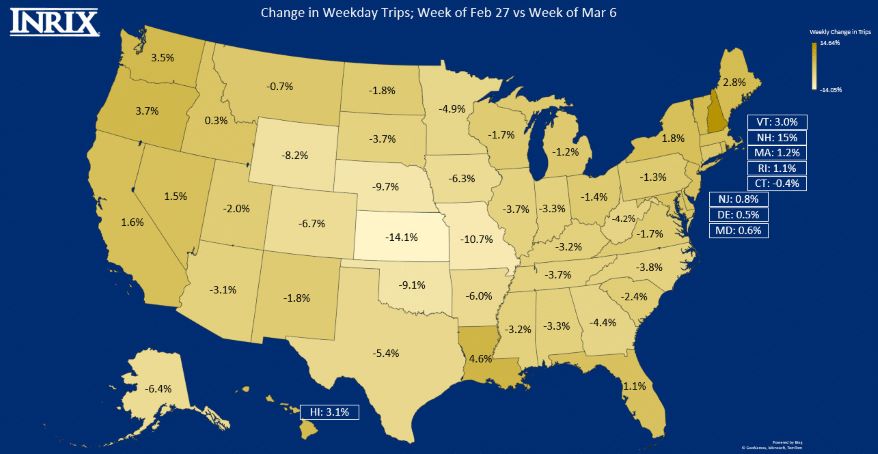Kansas City Braces for Long, Hot Summer of High Gas Prices Analysts Don't Expect Price Relief for Months
Published June 14th, 2022 at 6:00 AM
Above image credit: The average gas price in Missouri stood at $4.679 on Monday. Quik Trip is a major gas retailer in the area. (Saurav Rahman | Flatland)“Oh, it is high. Too high.”
Those are the words Jessica Davis utters after reaching one of the gas stations on Kansas City’s Main Street. The 34-year-old yoga instructor feels the same every time she refuels her black SUV these days.

“It is more money out of my budget,” Davis said. “I cannot discontinue traveling because I have a child who plays sports. So, I have to drive around more, so more money.”
Davis is constantly running the numbers in her head.
“I probably spend around $200 per month for gas, if I had done everything I needed to do,” she said. “Last summer maybe I spent $120 a month on gas. Now I’m spending more than $80 more per month.”
According to the American Automobile Association (AAA), on June 13 regular gas sold for an average of $4.679 per gallon in Missouri, which is 69.4% higher than the same date last year. Nationwide, the average price of gas stood at $5.014 per gallon. Although prices in Missouri remain below the national average, local prices have increased at a faster rate over the past year.
Mike Stellern, professor of economics at Rockhurst University, cites several factors that have contributed to higher prices.
“There’s been a decrease of about 10% of oil coming out of Russia,” Stellern said. “Given the fact that we’ve got the war between Russia and Ukraine, this has seriously impacted what Russia has been able to send out to the rest of the world. And this 10% decrease is impacting what is happening in the United States.
“Secondly, after the pandemic, people are returning to the office environment and starting to travel. This is a tremendous increase in the gasoline demand. And this increase is causing the price of a gallon of gasoline to just soar.”
Despite soaring prices here and across the country, Missouri and Kansas still have some of the lowest prices nationwide. Missouri ranks at 40 and Kansas at 42 among the 50 states plus the District of Columbia..
Nick Chabarria, public affairs specialist at AAA Missouri, explained how the state gets a price advantage over others.
“The main contributing factor in gas price differences among states is state fuel tax rate. Missouri and Kansas have relatively low fuel tax rates, ranking 11th and 23rd lowest of the 50 states and D.C., respectively,” he said. Missouri’s current fuel tax rate is 19.5 cents while Kansas’ is 24 cents.
“Missouri and Kansas are also near major gasoline supply hubs, which cut down on fuel transportation costs resulting in lower-than-average pump prices,” Chabarria said.
Those factors, though, only take some of the sting out of surging gas prices. The same might be said for adjusting for inflation.
The United States last experienced a gas price shock in the summer of 2008, when the average price reached $4.11 per gallon. After adjusting for inflation over the past 14 years, that $4.11 price in July 2008 is equal to $5.40 in current dollars.
Professor David M. Mitchell, director of the Bureau of Economic Research at Missouri State University, isn’t taking any comfort in inflation adjustments. He’s convinced the inflation situation is more fragile now than in 2008.
“Fourteen years ago, it was essentially just the price of gas that was going up,” Mitchell said. “And now you have the price of gas, you have the price of food, you have the price of housing, everything is going way up. So, it’s not just this one thing. And when you look at it in terms of maybe a share of your budget, it does seem pretty high.”
Economist Steve Reed from the Information and Analysis Section (Consumer Price Index) of the Bureau of Labor Statistics, described the impact of the energy price hike on all other products and services.
“Energy is 8.295% of the weight in the Consumer Price Index (CPI) market basket and had an effect of 2.086% on all items index,” Reed said.
The most recent inflation data shows overall energy prices had risen about 34.6% over the past year, compared to an overall inflation rate of 8.6%.
This expenditure hike has forced Asif Iqbal Khan to change his lifestyle, which he has maintained for a long time. The federal IT employee has to commute 30 miles every day to the workplace from home.
“My colleagues and I were discussing carpooling because I have to spend almost $30 per week just to go to the office,” Khan said. “It’s tough to afford. For this, I now had to sacrifice my hobbies, traveling and fishing.”

Khan has a Jeep Wrangler in his garage. However, it has been a while since he drove that vehicle because it consumes more gas than average.
“During these five summer months, I usually travel at least four long trips,” Khan said. “I had planned to go to Lake Ozark, but it became uncertain due to the current condition.”
That financial tension appears to be spreading to a large portion of the population. The AAA travel forecast for the Memorial Day holiday showed that travel in Missouri might be reduced by 12% compared to the pre-pandemic situation in 2019.
“We have seen in the past when sustained higher fuel prices did impact travel plans because of the erosion of discretionary dollars,” said AAA Public Affairs Specialist (II) Don Redman. “In those scenarios, people continued to travel, but perhaps changed plans to travel shorter distances or shortened the duration of their travel plans.”
Another poll by AAA Kansas (including all of the state except Kansas City area drivers), also provides a look into how gas prices become a factor in travelers’ plans. According to that survey, 42% are taking fewer or shorter trips because of gas prices. Also, 16% will adjust their budget for lodging or food because of gas prices. And those who are staying home or are unsure about their summer travel plans, more than one-third cite gas prices as the biggest factor influencing that decision.
Shawn Steward, public and government affairs manager of AAA Kansas, said, “This poll took place before the most recent significant jump in prices, so people may feel a bit differently now if asked.”
Those forecasts are becoming reality now as nationwide travel has decreased over the past few months.
According to a data analysis firm Inrix, vehicle trips on weekdays fell by around 2% in March from February. However, in the same period in Kansas state driving decreased by 14%, which is the highest in the list, followed by Missouri’s 11% decline in driving. According to that survey, there was no other state with a double-digit drop.
Demand Destruction

So, what does the future hold? AAA Missouri advised its members to budget for $4.50 a gallon of gasoline this summer. However, prices have already surpassed that figure.
Mitchell, the Missouri State University economist, expects increases to continue “throughout the rest of the summer.”
Much depends on how much people alter their behavior.
“I think if people are planning a trip to the beach this summer, then they’re not buying gas in Missouri,” Mitchell said. “They’re buying gas from Alabama or South Carolina or Florida or whatever. So, it’s the local trips, I think that people will try to start cutting back or trying to consolidate their trips and things like that. So, we might not see it go above $5 in Missouri itself. But even though nationwide … it’s already above $5 and will probably continue to go higher.”
One possible policy response, reducing gas taxes, would not be a good solution, Mitchell said.
“The tax is not borne completely by consumers, some of it is borne by producers, they share the tax,” he said. “The best thing that people can do short term this summer is to try to consolidate their trips.”
Although oil and gas is a worldwide market, Mitchell noted that domestic political policy has an impact.
“I think President Biden bears a lot of responsibility for the increases in gas prices because he said repeatedly that he wants fossil fuels to be gone,” Mitchell said. “And so, what that means is that fossil fuel firms, oil and gas companies said: ‘Look, there’s no point in making investments in fields and trying to drill and things like that. He’s just going to take it all away anyway. There’s just no point to it.’ So, in that sense, I think he does share some of his responsibility. And until he changes his mind on that, you’re not going to see oil and gas companies going out and doing lots of drilling.”
Professor Stellern also thinks the only way to get prices down is to start pumping more oil out of the ground and refining it.
“I think that is underway,” Stellern said. “But it’s going to take a while for it to have an impact on prices. So, I certainly do think that this summer, gasoline prices will continue to soar and you won’t see any stabilization or declining gas prices until more into the fall of 2022.”
In that reality, AAA advises drivers to increase gas mileage and help save some money at the pumps this summer. The association suggested avoiding traveling during peak traffic times and reducing highway speeds by five to 10 miles per hour, which can increase fuel economy by as much as 14%.
Saurav Rahman is a 2022 visiting fellow through the Alfred Friendly Press Partners program, which provides hands-on training in U.S. and international newsrooms and within the Missouri School of Journalism. He is a senior reporter for Maasranga Television in Bangladesh.


